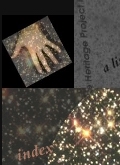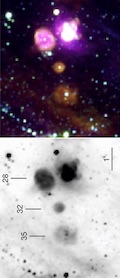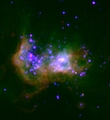



HII Regions in Spiral Galaxies: Size Distribution, Luminosity Function, and New Isochrone Diagnostics of Density Wave Kinematics,
M.S. Oey, J.S. Parker, V.J. Mikles, & X. ZhangWe investigate the relationship of the HII region luminosity function (HII LF) to the HII region size distribution and density wave triggering in grand-design spiral galaxies. We suggest that the differential nebular size distribution is described by a power law of slope ~ -4, , with flattening at radii below ~130 pc. This contrasts with the conventional exponential description, but it is physically and quantitatively consistent with the typical observed value of -2 for the HII LF slope. We have developed an interactive code that computes spatial isochrones for the evolving loci of spiral density waves in disk galaxies. This allows comparison of the nebular spatial distribution with the spatial isochrones for simple rotation curve parameters. Our comparisons for four grand-design galaxies suggest that the corotation radius r_co coincides with the outer ends of the star-forming arms. This value for r_co yields the best spatial correspondence between the HII regions and the isochrones, and also appears to yield a coincidence between the Inner Lindblad Resonance with the radial onset of star formation in the arms. Thus, we suggest that isochrones offer a new, simple, and effective technique for determining r_co , and thus the spiral pattern speed. However, application of the isochrones also demonstrates that evolution of the nebular population is difficult to spatially isolate in these galaxies. AJ, 126, 2317
|

